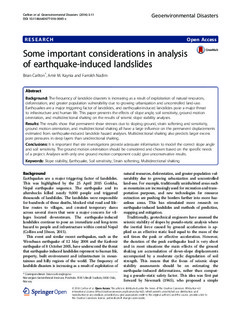| dc.description.abstract | BACKGROUND
The frequency of landslide disasters is increasing as a result of exploitation of natural resources, deforestation, and greater population vulnerability due to growing urbanization and uncontrolled land-use. Earthquakes are a major triggering factor of landslides, and earthquake-induced landslides pose a major threat to infrastructure and human life. This paper presents the effects of slope angle, soil sensitivity, ground motion orientation, and multidirectional shaking on the results of seismic slope stability analyses.
RESULTS
The results show that permanent shear stresses due to sloping ground, strain softening and sensitivity, ground motion orientation, and multidirectional shaking all have a large influence on the permanent displacements estimated from earthquake-induced landslide hazard analyses. Multidirectional shaking also predicts larger excess pore pressures in deep layers than unidirectional shaking.
CONCLUSIONS
It is important that site investigations provide adequate information to model the correct slope angle and soil sensitivity. The ground motion orientation should be considered and chosen based on the specific needs of a project. Analyses with only one ground motion component could give unconservative results. | |
